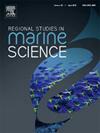Assessing trawls size selectivity in Antarctic krill: The role of sex and maturity stages
IF 2.1
4区 环境科学与生态学
Q3 ECOLOGY
引用次数: 0
Abstract
Understanding the connection between maturity stages and morphology in relation to size selectivity in trawls is essential for assessing the impact of various fishing gear on the population structures of harvested species, their fishing mortality rates, and the efficiency of the gear used. The Antarctic krill (Euphausia superba) fishery is the largest in the Southern Ocean by volume, and there is increasing interest in expanding the industry. The krill fishery employs different trawl designs and is not currently subject to technical regulations specifying the types of fishing gear and mesh sizes that can legally be used. There is a need to establish a robust model predicting size selectivity that includes the morphological variation in the population of krill. Male and female Antarctic krill are described with 12 maturity stages, from juveniles to sexually mature adults, each with distinct morphological features. The current study established a morphological description of each individual krill maturity stage to identify and parameterize what determines size selectivity using the FISHSELECT framework. This framework is used to predict size selectivity for each of the different stages in various mesh sizes and openings relevant to the krill fishery, in both actual and virtual populations. The results can be used to assess size selectivity for specific fishing gears and population structures, facilitating more accurate understanding and modeling of the fishery’s impact on the demographic composition of the krill stock.
评估南极磷虾拖网尺寸的选择性:性别和成熟期的作用
了解拖网中成熟阶段和形态与尺寸选择性之间的联系,对于评估各种渔具对收获物种种群结构、捕捞死亡率和所用渔具效率的影响至关重要。南极磷虾(Euphausia superba)捕鱼业是南大洋中最大的捕鱼业,人们对扩大该产业的兴趣日益浓厚。磷虾渔业采用不同的拖网设计,目前不受技术法规的限制,该法规规定了可以合法使用的渔具类型和网目尺寸。有必要建立一个强大的模型,预测大小的选择,其中包括磷虾种群的形态变化。雄性和雌性南极磷虾有12个成熟阶段,从幼年到性成熟的成年,每个阶段都有不同的形态特征。目前的研究建立了每个磷虾个体成熟阶段的形态学描述,以识别和参数化使用FISHSELECT框架决定大小选择性的因素。该框架用于预测与磷虾渔业相关的各种网孔尺寸和开口的每个不同阶段的尺寸选择性,包括实际种群和虚拟种群。研究结果可用于评估特定渔具和种群结构的大小选择性,有助于更准确地理解和建模渔业对磷虾种群人口组成的影响。
本文章由计算机程序翻译,如有差异,请以英文原文为准。
求助全文
约1分钟内获得全文
求助全文
来源期刊

Regional Studies in Marine Science
Agricultural and Biological Sciences-Ecology, Evolution, Behavior and Systematics
CiteScore
3.90
自引率
4.80%
发文量
336
审稿时长
69 days
期刊介绍:
REGIONAL STUDIES IN MARINE SCIENCE will publish scientifically sound papers on regional aspects of maritime and marine resources in estuaries, coastal zones, continental shelf, the seas and oceans.
 求助内容:
求助内容: 应助结果提醒方式:
应助结果提醒方式:


